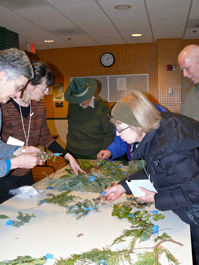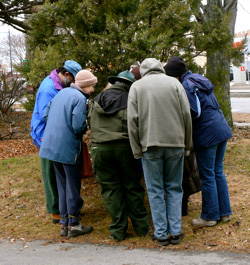February 28, 2010
Evergreens at Fresh Pond
Left photo: Ranger Jean Rogers (wearing green hat) helps
participants sort evergreen leaf and branch samples in the CWD cafeteria.
Middle photo: (clockwise from lower right) Some leaf samples
participants learned to identify with their characteristics are: White
Spruce (Picea glauca) the leaves are needles which have an unpleasant
order when bruised (crushed); American Holly (Ilex opaca) a native
broadleaf shrub; Eastern White Pine (Pinus strobus) a conifer
whose needles are clustered in a bundle of five needles; Arborvitae
aka Northern White Cedar (Thuja occidentalis) has scale like
leaves that spread out in flat, fan shaped sprays; (middle) Inkberry
(Ilex glabra) another native broadleaf shrub with leathery leaves
that are bicolor, shiny and dark above, lighter and dull on the underside.
Right photo (tree in background): Participants gather
around Ranger Jean Rogers and learn how to identify an Eastern Red Cedar
(Juniper) (Juniperus virginiana) which incorrectly was given
the common name of cedar because it has berries and scales (like cedars),
but Eastern Red Cedars have awls, a key factor in identification, since
cedars do not have awls. In fact, Eastern Red Cedars are junipers that
are members of the juniper genus.
Description and Photos by Carol Collura





